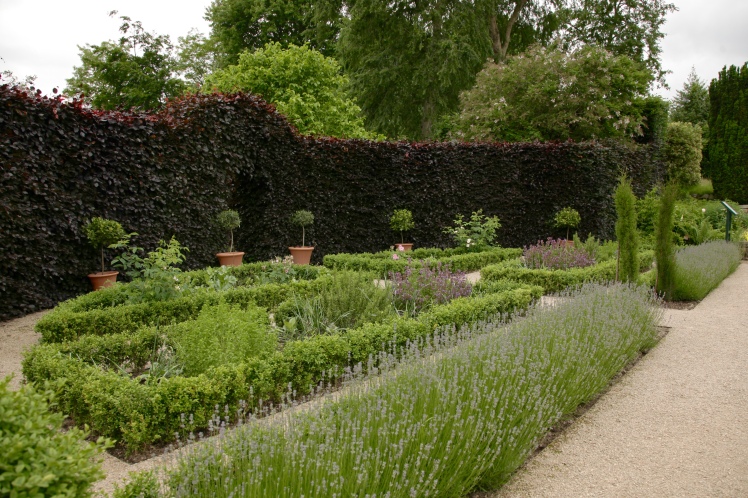
All good gardens impart narrative; that is, they exist in conversation with the surrounding landscape, evoke memories of the past and give meaning to the future. Good gardens tell the story of their makers. Yet over time, that story often becomes not a permanent account of a fixed moment in time, but a fluid exchange which is as changeable as the people who engage with it. As the world changes so too does the meaning of the gardens we make within it. This concept of a constant but supple narrative, able to shift with time and place, has allowed University of Birmingham PhD researcher, Miriam Bay; landscape designer and author, Kathryn Aalto and the Winterbourne team, to create a garden which unites together the seemingly disparate influences of contemporary Birmingham, Roman antiquity and Edwardian England.
‘Ovid’s Garden’ was first conceived of by Miriam two years ago following the acceptance of her PhD proposal, Cultivating Narrative and Composing Landscape: Reading Ovid in the Italian Renaissance Garden. Kathryn finalised her design of the garden in November 2014 when work quickly began to install the hard landscape and plant many of the spring bulbs integral to the garden. More planting followed again in the spring of 2015, before a period of maturation preceded the garden’s opening at ‘Ovid’s Garden Party’, in June of this year.
Ovid was a Roman poet born in 43 BC. His most influential work, Metamorphoses, a compendium of ancient Greek and Roman mythology, describes many fabled locations such as the distant Hesperides – a garden at the westernmost edge of the world, where an unsleeping dragon guards a tree bearing golden fruit. These mythical landscapes, in which an unsuspecting tree or flower may suddenly become the victim of metamorphosis, as was the nymph Daphne who was transformed into a laurel to escape the amorous advances of Apollo, often informed the narrative of Italian Renaissance gardens. Here visitors are transported to a world of powerful enchantresses and malevolent deities through the sensory and somatic experiences provoked by the plants of antiquity.
“An authentic interpretation of the Italian Renaissance would likely look out of place in the average domestic garden. However, many of the fundamental principles behind the style can still be used in conjunction with others to good effect. Use symmetrical potted displays to provide your garden with a sense of order, grow scented plants near path edges to stretch the senses beyond the visual, and create a sense of intimacy by compartmentalising your garden into a series of connected but secluded areas.” Stephen Haines, Head Gardener, Winterbourne House and Garden

In designing Ovid’s Garden, Kathryn hoped to not only to reflect ancient Roman literature, but the experiences of Winterbourne’s original designer and occupant Margaret Nettlefold: “With its Italian cypresses and boxwoods, Ovid’s Garden is Italianate with reference to classical history. My main concern was that it be rooted in the family history and the place, to feel like the Nettlefold family had a hand in its design. Once I learned through research that John and Margaret Nettlefold had spent time in Italy and Margaret painted watercolours of her Italian travels, there was a true link to celebrate, and I feel that I achieved that.”

The Nettlefolds visited Italy four times between 1901 and 1913. Margaret describes each trip in her diary now held at the Winterbourne archive. She notes in particular the beauty of the Italian landscape and its native flora. On their first trip, the Nettlefolds visited the gardens of Latornia dei Cappuccini, which have been fashioned from a quarry once used by victorious Athenian authorities to imprison local troops who either died at the bottom of the abyss or were later sold into slavery. Margaret enthuses about the gardens, which she explored after breakfast, finding it in parts overgrown with wild olive and fig trees and in other parts well maintained with carefully arranged details such as a veranda filled with the scent of roses, heliotrope, lavender and orange blossom. Conversely, Margaret was equally disposed to criticise those aspects of Italianate design which offended her sensibilities. On her final visit to Italy in 1913, Margaret describes the gardens of Baveno in complimentary terms before declaring many of the statues and terraces to be crafted in: ‘hideous taste’.
“No Italianate garden would be complete without an olive tree (Olea eurpaea). In milder parts of the country a free draining, south or west facing bed will make a suitable location. In cooler areas it is better to grow your olive tree in a container which can be transferred to a frost free place when the weather deteriorates. Luckily, olives regenerate well from the base. If you do lose top growth to low temperatures you can simply prune your tree to ground level in spring and start again.” Stephen Haines, Head Gardener, Winterbourne House and Garden

This transitory link to the Nettlefolds’ past made situating ‘Ovid’s Garden’ within the existing garden a critical process. Kathryn began by considering the climatic conditions provided by different sites: “Originally there was another site in mind for the garden, a tighter place closer to the house but under a few trees. Italian gardens love sunshine so I searched for a more exposed location. It wasn’t difficult to find. Once I saw the semi-circular copper beech hedges at Winterbourne, it reminded me of curved amphitheatres I’d seen in some gardens in Florence. There was more sunshine there, greater space for paths to interact with the garden and generally a feeling that this new garden could quickly feel a part of the wider Winterbourne space. A bonus was that far across the expanse of existing lawn from this mature hedging was a singular urn. It looked as if Margaret could have brought this to Winterbourne herself from Italy. It was an appropriate ‘borrowed view’ if you will. At Ovid’s Garden Party in June, I was delighted to see that Winterbourne had actually borrowed from Ovid’s Garden. That urn I so loved is now surrounded by a circular planting of boxwood and now mirrors the planting beds lined in boxwood in Ovid’s Garden.”
“Box blight can quickly destroy box plants leaving topiary and parterres bereft of foliage. Increasing airflow around your box by not crowding them with other plants and avoiding watering them from above will help to prevent box blight spreading which thrives in still and humid conditions. The best defence of all is to avoid planting box altogether. Use alternatives such as Ilex crenata and Lonicera nitida which respond equally well to clipping and have similarly attractive dense evergreen leaves.” Stephen Haines, Head Gardener, Winterbourne House and Garden

In conjunction with Winterbourne the creation of ‘Ovid’s Garden’ has been supported financially by the AHRC Midlands Three Cities Doctoral Training Partnership and the University of Birmingham. It is now hoped that the garden will become an affecting and accessible piece of living interpretation which can be enjoyed by all and in particular those beyond the academic sphere. This kind of public facing engagement began at the garden’s opening, ‘Ovid’s Garden Party’, where members of the public were invited to hear talks by both Miriam and Kathryn on their involvement with the garden and their thoughts on the fusion of art, literature and landscape embodied by its design, alongside performances of episodes from Ovid’s Metamorphoses by Roman pantomime theatre group ‘Avid for Ovid’. ‘Ovid’s Garden’ will be further used as a focal point for interactive workshops exploring the use of plants in ancient cooking, ritual, medicine and perfumery. Click here to find out how you too can visit Winterbourne and examine the plants of ancient Roman botany or smell the scents of Margaret Nettlefold’s Italy.
There’s more than one way to dig it; just click ‘Get Digging!’ at the top of the page and you’ll be able to follow the blog by email, or share your favourite posts on Facebook and Twitter by clicking the icons below.




“All good gardens impart narrative.” Indeed. And what a narrative here. Congratulations from Indiana to everyone who created this. And thank you for stretching my brain in a whole new way!
LikeLiked by 2 people
Greetings from Birmingham. A bit of brain stretching is always good isn’t it?! Ovid’s garden is looking great at the minute with lots of herbs in full flower such as Lavender – and of course that purple beech hedge looks so dramatic all summer long!
LikeLike
Fascinating … and a brilliant and innovative way to bring the garden to life and add to its meaning.
LikeLiked by 1 person
Hello Annie. Glad you enjoyed reading all about ‘Ovid’s Garden’ – it has been a wonderful addition to Winterbourne. It has been really interesting for us to introduce a different aspect of design to the gardens and use some plants which we may previously have overlooked.
LikeLiked by 1 person
Reblogged this on naso's song and commented:
Winterbourne’s review of Ovid’s Garden Party!
LikeLike
It was a delight to design and I’m glad it has fit into the Winterbourne narrative so beautifully.
LikeLike
Thanks Kathryn. Hope you get chance to swing by in future and see how the garden is coming along.
LikeLike
Thank you for sharing the making of a garden, from idea to completion – a wonderful tale!
LikeLike
Hello Lynn, not a problem – glad you enjoyed reading all about it. The lavender which was planted at the front of the garden is still flowering its head off looking spectacular in front of the beautiful purple beech hedge.
LikeLiked by 1 person